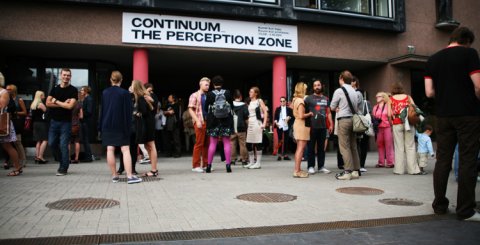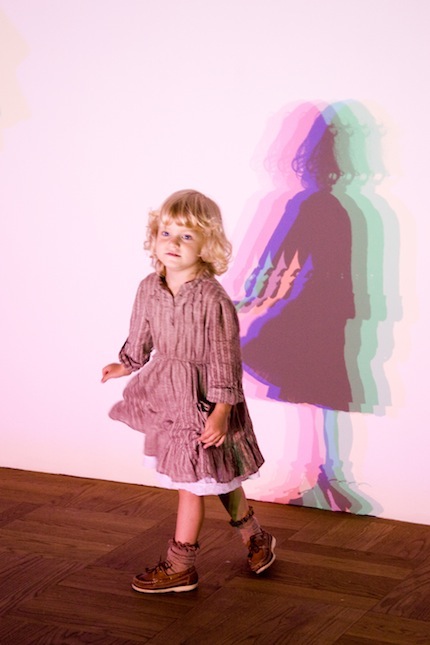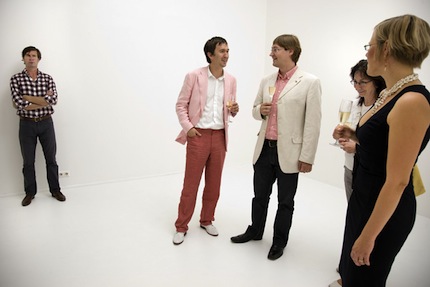
Tomb Raider of Inner Space
05/09/2011
The exhibit "Continuum_the Perception Zone" is on view at Tallinn’s Kunstihoone from August 26 through October 2.
An extensive exhibit of light and sound installations, with a constellation of international artists, is now on display in the 400-square-meter second floor of Tallinn’s Kunstihoone Art Hall. Not only is the space itself very expansive, but the names of the artists exhibited there resonate far and wide. In the Baltic region, it’s not every day that you get to see a 2010 light installation by Olafur Eliasson (1968), Your Uncertain Shadow, or Martin Creed’s (1968) Work Nr. 227 (2000), which a decade ago was awarded the prestigious Turner Prize, as well as works by seven more artists—all in one place.
But still, in choosing to combine in the exhibit the most exemplary works by these artistic stars, the young Estonian curator Maria Arusoo (1983) must solve a difficult task. Though “seeing with your own eyes” may be an achievement that should be taken advantage of, it is nonetheless not a sufficient reason for the exhibit to be accurately assessed as good, right? An exposition with this content can easily become simply a mantelpiece holding a row of shiny trophies. Yet I must say right away that the curator has honorably fulfilled the task of not falling into this particular ditch. Each installation serves as an element with its specific function in the exhibit as a whole, where the works don’t oppress one another and conceptually fit together.
A Journey in Search of Preconceptions
In short, the central aspect of the exhibit is the interaction between people and space. The exposition’s concept explains this as follows: “The three-dimensionality of an exhibition hall is the parameter upon which the visitor relies without thinking, but this exhibition centralizes it and reconsiders preconceived notions.” The installations chosen by the curator assemble a trail of knowledge which visitors can move down, abandoning themselves to games of perception. Just like in an adventure movie or computer game, the visitors must beat several levels (nine installations) in order to arrive at a treasure chest and acquire more flexible preconceptions about spatiality, which transforms from something self-evident to something miraculous.
Continuum
In a group show where the exhibited works were made in the last ten years, I doubt a critic’s task is to assess, for example, the quality of an installation by Martin Creed created a while back, or video works by the artistic duo John Wood (1966) and Paul Harrison (1969) from the Tate collection. This, of course, may be done; yet this time I think precisely the curator’s work should be subjected to analysis: the exhibit’s concept, choice of works, and the embodiment of the conception in real life.
The central theme of the exposition is described with the word “continuum,” mentioned in the title. Our perception works by perceiving the surroundings as an undivided whole of time and space, thereby granting meaning to the horde of perceptions. The human senses and their principles of activity are always a fruitful field where artists can experiment and search for a muse. Yet what seems engaging to me is that Maria Arusoo has solved the “continuum” on two levels, not only in terms of content but also in the very structure of the exhibit.
In a broader sense, continuum means an uninterrupted series or combined whole, which consists of at least two elements and whose parts are mutually linked. You could huff that this definition already applies to any thematic exhibition; yet you don’t always get to see a truly well-considered and polished selection of works, and even more rarely do you see examples where the selection’s theme reverberates with the structure of the exhibit. But what is truly rare are exhibits that awaken the knowledge of “Gestalt theory”—stored away somewhere—in which one of the main tenets is the thesis that the whole determines the particularities of its parts, not the other way around. This would explain how it is possible to place works of art alongside each other—works that are thick as slices of cake in the cultural layer—in such a way that they quietly coexist in the exhibition hall and enhance one another, without leading to oversaturation. The whole of the exhibit perhaps rules over each individual work.
The Whole and its Parts
The exhibit is made of up nine installations; each has been granted a separate room. I think that two of the works “fall out” of the whole: the Austrian artist Bernhard Leitner’s SOUNDMIRRORPATH (2011), found as soon as you climb up to the second floor; and the Estonian artist Toomas Thetloff’s air sculpture Displaced Air Particles (2011), which seems like an interesting idea but doesn’t convince when viewed in the context of the exhibit as a whole. Leitner’s otherwise roughly elegant sculpture doesn’t seem to be in the right place or the right time, because it is possible to imagine the exhibit without it.
The other seven installations form an intriguing whole, which begins with British artist Martin Creed’s Work Nr. 227: The Lights Going On and Off. The largest hall of Kunstihoone is ruled by an acoustic emptiness, in accordance with the parameters of the work of art, but the ceiling lamps switch on and off every five seconds. The most widespread interpretations explain this as a reminder that, without such an obvious element as the gallery’s lighting, the enjoyment of a work of art would be paralyzed. Arriving in the situation conjured up by Creed, you understand that such seemingly secondary things in fact have a decisive role. The installations is a strong introduction to the exhibit, and regulates visitors’ senses to the necessary frequencies. Next follows a long foyer where the video installation Peel (2003), by Berlin-based artist Ceal Floyer (1968), is projected on the walls. Slowly the wall is peeled off, revealing it to be gray, and then this is peeled again anew. And then like Lara Croft you arrive at the next level, where you begin to peel away your preconceived notions, one skin after another, unmasking your accustomed preconceptions.

Photo: Aime & Priit Estna
Next comes a small walk-through space with the light installation Your Uncertain Shadow by Icelandic/Danish artist and researcher Olafur Eliasson. Whenever someone crosses the room, projectors placed on the floor throw colored shadows through various filters onto the opposite wall. When you look at yourself from a distance, you find that even your shoelaces have divided into rainbow colors. The work set up in the next space, the neon lamp installations Shadows (After Atget) (2007) by New York-based artist Spencer Finch (1962), harmonizes both in terms of its colorfulness and the artist’s scientific approach.
The uniform mood that threatens to take over the exhibit is switched at just the right moment, by a dark space with a video work from the inseparable British artistic duo John Wood and Paul Harrison, Twenty Six (Drawings and Falling Things) (2001), a film included in the Tate collection. First-class humor, a “hard” face about the relationship between people and space. Follows this is a room featuring the sound installation The Infinite Number of Artworks (2010) by Estonian experimental artist KIWA, which upholds the humorous note and conceptually chuckles about the constellation of world-class works of art which the visitor has just walked through. All the viewer sees are two black speakers, arranged on opposite walls, playing a Ping-Pong of words: the voices of an anonymous man and woman reading off a list of artworks, describing them with just as anonymous numbers, generated according to the principle of chance.

Photo: Aime & Priit Estna
Finally comes the last space, a room illuminated in a bright whiteness almost unbearable to the eye; if it were just a little brighter, then you would completely lose all perception of spatial boundaries. Little speakers are set up in the corners, playing what is going on in the other spaces. The artists behind the installation Ultimate Encounter Zone (2011) are the curator’s alterego, Marusoo, in tandem with the Berlin-based Italian artist Daniel Kemeny (1981). The idea was to create a place where there aren’t any other enticements besides an all-encompassing white light, generating an association with entering your “inner space,” to spend some time and accumulate the impressions you just acquired. The End.
Who Will Like it, Who Won't
Those who have come to be excited, shocked, and thrilled by works of art may not like the exhibit. Of course, all this may be individually experienced, but the standard model of viewer/artwork, subject/object doesn’t work in the exhibit. Instead, it is an elegant D.I.Y. (Do It Yourself), because the viewer is placed eye-to-eye with his preconceptions, rather than with a work of art. The imperceptible, immaterial light and sound artworks are just the middleman that quicken this process. Undoubtedly, an aesthetically enjoyable intermediary. Some people may be bored by this model, while others will experience it as a meditation overseen by art.
Some may require something spicier at the exhibit, perhaps even something that doesn’t fit. At first, I too had the desire to cover the floor of one room with sticky soil. Something like an itch for a drop of tar in the honey pot. Yet the need vanishes, after thinking about and perceiving the exhibit as a whole and reflecting on space. To dump out a load of soil, leaving footprints everywhere, would be like feverish attempts not to give in to the rules of the game, which prescribe an abandonment of our customary understanding of spatiality.
I am convinced that visitors to the exhibit will divided into two fronts. One battalion will be annoyed by the jeweler’s perfection at the exhibit; the other will be inspired. They will be inspired to go on an inner journey to review the activity of automatic perception, as well as inspired by the exhibit’s courage and sweep, seeing that one of the first extensive exhibits devoted just to light and sound installations is going on right here in Tallinn. All the best.